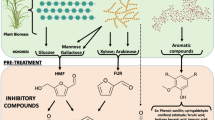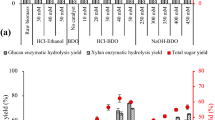Abstract
Bioconversion of lignocellulose to biofuels suffers from the degradation compounds formed during pretreatment and acid hydrolysis. In order to achieve an efficient biomass to biofuel conversion, detoxification is often required before enzymatic hydrolysis and microbial fermentation. Prehydrolysates from ethanol organosolv-pretreated pine wood were used as substrates in butanol fermentation in this study. Six detoxification approaches were studied and compared, including overliming, anion exchange resin, nonionic resin, laccase, activated carbon, and cysteine. It was observed that detoxification by anion exchange resin was the most effective method. The final butanol yield after anion exchange resin treatment was comparable to the control group, but the fermentation was delayed for 72 h. The addition of Ca(OH)2 was found to alleviate this delay and improve the fermentation efficiency. The combination of Ca(OH)2 and anion exchange resin resulted in completion of fermentation within 72 h and acetone–butanol–ethanol (ABE) production of 11.11 g/L, corresponding to a yield of 0.21 g/g sugar. The cysteine detoxification also resulted in good detoxification performance, but promoted fermentation towards acid production (8.90 g/L). The effect of salt on ABE fermentation was assessed and the possible role of Ca(OH)2 was to remove the salts in the prehydrolysates by precipitation.









Similar content being viewed by others
References
Sheelanere, P., & Kulshreshtha, S. (2013). Sustainable biofuel production: opportunities for rural development. International Journal of Environment and Resource, 2, 1–13.
García, V., Päkkilä, J., Ojamo, H., Muurinen, E., & Keiski, R. L. (2011). Challenges in biobutanol production: how to improve the efficiency? Renewable and Sustainable Energy Reviews, 15(2), 964–980.
Naik, S., Goud, V. V., Rout, P. K., & Dalai, A. K. (2010). Production of first and second generation biofuels: a comprehensive review. Renewable and Sustainable Energy Reviews, 14(2), 578–597.
Clark, T. A., & Mackie, K. L. (1984). Fermentation inhibitors in wood hydrolysates derived from the softwood Pinus radiata. Journal of Chemical Technology and Biotechnology, 34, 101–110.
Klinke, H. B., Olsson, L., Thomsen, A. B., & Ahring, B. K. (2003). Potential inhibitors from wet oxidation of wheat straw and their effect on ethanol production of Saccharomyces cerevisiae: wet oxidation and fermentation by yeast. Biotechnology and Bioengineering, 81(6), 738–747.
Mussatto, S. I., & Roberto, I. C. (2004). Alternatives for detoxification of diluted-acid lignocellulosic hydrolyzates for use in fermentative processes: a review. Bioresource Technology, 93(1), 1–10.
Larsson, S., Palmqvist, E., Hahn-Hägerdal, B., Tengborg, C., Stenberg, K., Zacchi, G., & Nilvebrant, N.-O. (1999). The generation of fermentation inhibitors during dilute acid hydrolysis of softwood. Enzyme and Microbial Technology, 24(3-4), 151–159.
Baral, N. R., & Shah, A. (2014). Microbial inhibitors: formation and effects on acetone-butanol-ethanol fermentation of lignocellulosic biomass. Applied Microbiology and Biotechnology, 98(22), 9151–9172.
Palmqvist, E., & Hahn-Hägerdal, B. (2000). Fermentation of lignocellulosic hydrolysates. I: inhibition and detoxification. Bioresource Technology, 74(1), 17–24.
Amartey, S., & Jeffries, T. (1996). An improvement in Pichia stipitis fermentation of acid-hydrolysed hemicellulose achieved by overliming (calcium hydroxide treatment) and strain adaptation. World Journal of Microbiology and Biotechnology, 12(3), 281–283.
Parajó, J., Domínguez, H., & Domínguez, J. (1997). Xylitol production from Eucalyptus wood hydrolysates extracted with organic solvents. Process Biochemistry, 32(7), 599–604.
Chi, Z., Rover, M., Jun, E., Deaton, M., Johnston, P., Brown, R. C., Wen, Z., & Jarboe, L. R. (2013). Overliming detoxification of pyrolytic sugar syrup for direct fermentation of levoglucosan to ethanol. Bioresource Technology, 150, 220–227.
Mohagheghi, A., Ruth, M., & Schell, D. J. (2006). Conditioning hemicellulose hydrolysates for fermentation: effects of overliming pH on sugar and ethanol yields. Process Biochemistry, 41(8), 1806–1811.
Persson, P., Andersson, J., Gorton, L., Larsson, S., Nilvebrant, N.-O., & Jönsson, L. J. (2002). Effect of different forms of alkali treatment on specific fermentation inhibitors and on the fermentability of lignocellulose hydrolysates for production of fuel ethanol. Journal of Agricultural and Food Chemistry, 50(19), 5318–5325.
Jennings, E. W., & Schell, D. J. (2011). Conditioning of dilute-acid pretreated corn stover hydrolysate liquors by treatment with lime or ammonium hydroxide to improve conversion of sugars to ethanol. Bioresource Technology, 102(2), 1240–1245.
Ranatunga, T. D., Jervis, J., Helm, R. F., McMillan, J. D., & Wooley, R. J. (2000). The effect of overliming on the toxicity of dilute acid pretreated lignocellulosics: the role of inorganics, uronic acids and ether-soluble organics. Enzyme and Microbial Technology, 27(3-5), 240–247.
Chandel, A. K., Kapoor, R. K., Singh, A., & Kuhad, R. C. (2007). Detoxification of sugarcane bagasse hydrolysate improves ethanol production by Candida shehatae NCIM 3501. Bioresource Technology, 98(10), 1947–1950.
Liu, K., Atiyeh, H. K., Pardo-Planas, O., Ezeji, T. C., Ujor, V., Overton, J. C., Berning, K., Wilkins, M. R., & Tanner, R. S. (2015). Butanol production from hydrothermolysis-pretreated switchgrass: quantification of inhibitors and detoxification of hydrolyzate. Bioresource Technology, 189, 292–301.
Alriksson, B., Cavka, A., & Jönsson, L. J. (2011). Improving the fermentability of enzymatic hydrolysates of lignocellulose through chemical in-situ detoxification with reducing agents. Bioresource Technology, 102(2), 1254–1263.
Cavka, A., Alriksson, B., Ahnlund, M., & Jönsson, L. J. (2011). Effect of sulfur oxyanions on lignocellulose-derived fermentation inhibitors. Biotechnology and Bioengineering, 108(11), 2592–2599.
Jönsson, L., Palmqvist, E., Nilvebrant, N.-O., & Hahn-Hägerdal, B. (1998). Detoxification of wood hydrolysates with laccase and peroxidase from the white-rot fungus Trametes versicolor. Applied Microbiology and Biotechnology, 49, 691–697.
Larsson, S., Reimann, A., Nilvebrant, N.-O., & Jönsson, L. J. (1999). Comparison of different methods for the detoxification of lignocellulose hydrolyzates of spruce. Applied Biochemistry and Biotechnology, 77(1–3), 91–103.
Pan, X., Arato, C., Gilkes, N., Gregg, D., Mabee, W., Pye, K., Xiao, Z., Zhang, X., & Saddler, J. (2005). Biorefining of softwoods using ethanol organosolv pulping: preliminary evaluation of process streams for manufacture of fuel-grade ethanol and co-products. Biotechnology and Bioengineering, 90(4), 473–481.
Yáñez-S, M., Rojas, J., Castro, J., Ragauskas, A., Baeza, J., & Freer, J. (2013). Fuel ethanol production from Eucalyptus globulus wood by autocatalized organosolv pretreatment ethanol–water and SSF. Journal of Chemical Technology and Biotechnology, 88, 39–48.
Pan, X., Xie, D., Kang, K.-Y., Yoon, S.-L., & Saddler, J. N. (2007). Effect of organosolv ethanol pretreatment variables on physical characteristics of hybrid poplar substrates. Appl Biochem Biotecnol, 136-140, 367–378.
Pan, X., Gilkes, N., Kadla, J., Pye, K., Saka, S., Gregg, D., Ehara, K., Xie, D., Lam, D., & Saddler, J. (2006). Bioconversion of hybrid poplar to ethanol and co-products using an organosolv fractionation process: optimization of process yields. Biotechnology and Bioengineering, 94(5), 851–861.
Pan, X., Xie, D., Yu, R. W., Lam, D., & Saddler, J. N. (2007). Pretreatment of lodgepole pine killed by mountain pine beetle using the ethanol organosolv process: fractionation and process optimization. Industrial & Engineering Chemistry Research, 46(8), 2609–2617.
Amiri, H., & Karimi, K. (2015). Improvement of acetone, butanol, and ethanol production from woody biomass using organosolv pretreatment. Bioprocess and Biosystems Engineering, 38(10), 1959–1972.
Zhu, J., & Pan, X. (2010). Woody biomass pretreatment for cellulosic ethanol production: technology and energy consumption evaluation. Bioresource Technology, 101(13), 4992–5002.
Cai, D., Zhang, T., Zheng, J., Chang, Z., Wang, Z., Qin, P.-y., & Tan, T.-w. (2013). Biobutanol from sweet sorghum bagasse hydrolysate by a hybrid pervaporation process. Bioresource Technology, 145, 97–102.
Kolb, M., Sieber, V., Amann, M., Faulstich, M., & Schieder, D. (2012). Removal of monomer delignification products by laccase from Trametes versicolor. Bioresource Technology, 104, 298–304.
Lu, C., Dong, J., & Yang, S.-T. (2013). Butanol production from wood pulping hydrolysate in an integrated fermentation–gas stripping process. Bioresource Technology, 143, 467–475.
Mechmech, F., Chadjaa, H., Rahni, M., Marinova, M., Akacha, N. B., & Gargouri, M. (2015). Improvement of butanol production from a hardwood hemicelluloses hydrolysate by combined sugar concentration and phenols removal. Bioresource Technology, 192, 287–295.
Qureshi, N., Saha, B. C., Hector, R. E., Dien, B., Hughes, S., Liu, S., Iten, L., Bowman, M. J., Sarath, G., & Cotta, M. A. (2010). Production of butanol (a biofuel) from agricultural residues: part II—use of corn Stover and switchgrass hydrolysates. Biomass and Bioenergy, 34(4), 566–571.
Xie, R., Tu, M., Carvin, J., & Wu, Y. (2015). Detoxification of biomass hydrolysates with nucleophilic amino acids enhances alcoholic fermentation. Bioresource Technology, 186, 106–113.
Masion, E., Amine, J., & Marczak, R. (1987). Influence of amino acid supplements on the metabolism of Clostridium acetobutylicum. FEMS Microbiology Letters, 43(3), 269–274.
Karlsson, S., Lindberg, A., Norin, E., Burman, L. G., & Åkerlund, T. (2000). Toxins, butyric acid, and other short-chain fatty acids are coordinately expressed and down-regulated by cysteine in Clostridium difficile. Infection and Immunity, 68(10), 5881–5888.
Girbal, L., & Soucaille, P. (1998). Regulation of solvent production in Clostridium acetobutylicum. Trends in Biotechnology, 16(1), 11–16.
Vasconcelos, I., Girbal, L., & Soucaille, P. (1994). Regulation of carbon and electron flow in Clostridium acetobutylicum grown in chemostat culture at neutral pH on mixtures of glucose and glycerol. Journal of Bacteriology, 176(5), 1443–1450.
Luo, H., Ge, L., Zhang, J., Zhao, Y., Ding, J., Li, Z., He, Z., Chen, R., & Shi, Z. (2015). Enhancing butanol production under the stress environments of co-culturing Clostridium acetobutylicum/Saccharomyces cerevisiae integrated with exogenous butyrate addition. PLoS One, 10(10), e0141160.
Heluane, H., Evans, M. R., Dagher, S. F., & Bruno-Bárcena, J. M. (2011). Meta-analysis and functional validation of nutritional requirements of solventogenic Clostridia growing under butanol stress conditions and coutilization of D-glucose and D-xylose. Applied and Environmental Microbiology, 77(13), 4473–4485.
Ezeji, T., Qureshi, N., & Blaschek, H. P. (2007). Butanol production from agricultural residues: impact of degradation products on Clostridium beijerinckii growth and butanol fermentation. Biotechnology and Bioengineering, 97(6), 1460–1469.
Maddox, I., Qureshi, N., & Roberts-Thomson, K. (1995). Production of acetone-butanol-ethanol from concentrated substrate using clostridium acetobutylicum in an integrated fermentation-product removal process. Process Biochem, 30, 209–215.
Qureshi, N., Saha, B. C., Hector, R. E., & Cotta, M. A. (2008). Removal of fermentation inhibitors from alkaline peroxide pretreated and enzymatically hydrolyzed wheat straw: production of butanol from hydrolysate using Clostridium beijerinckii in batch reactors. Biomass and Bioenergy, 32(12), 1353–1358.
Qureshi, N., Saha, B. C., Dien, B., Hector, R. E., & Cotta, M. A. (2010). Production of butanol (a biofuel) from agricultural residues: part I—use of barley straw hydrolysate. Biomass and Bioenergy, 34(4), 559–565.
Funding
This study received financial support from the National Science Foundation (NSF-CBET 1555633), Southeastern Sun Grant Center, United States Department of Agriculture (USDA-2010-38502-21854), and the United States Department of Agriculture-National Institute of Food and Agriculture (USDA-NIFA) through the Integrated Biomass Supply Systems (IBSS) project (2011-68005-30410).
Author information
Authors and Affiliations
Corresponding author
Ethics declarations
Conflict of Interest
The authors declare that they have no conflict of interest.
Rights and permissions
About this article
Cite this article
Li, J., Shi, S., Tu, M. et al. Detoxification of Organosolv-Pretreated Pine Prehydrolysates with Anion Resin and Cysteine for Butanol Fermentation. Appl Biochem Biotechnol 186, 662–680 (2018). https://doi.org/10.1007/s12010-018-2769-4
Received:
Accepted:
Published:
Issue Date:
DOI: https://doi.org/10.1007/s12010-018-2769-4




